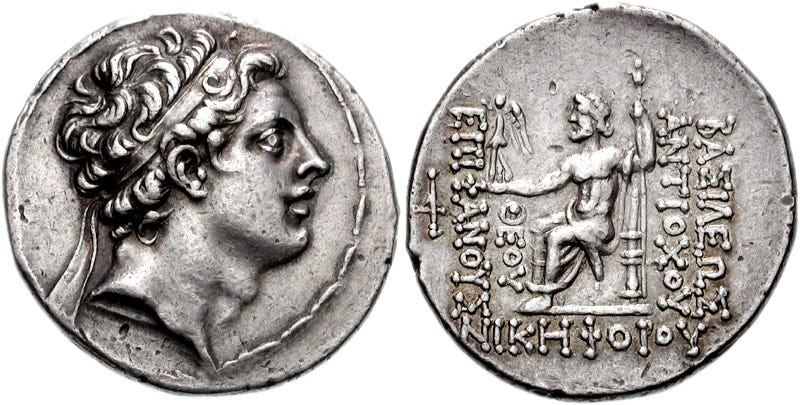From Pretrib Back to Prewrath: The Verse That Changed My Mind
Pretribulational scholars have some very interesting things to say. However, their arguments ultimately fail.
Background
Like many American Christians, I grew up with a pretribulational background. Upon discovering the prewrath view as a young man, I defended that view for 18 years. In recent days, I had been reading some pretribulational scholarship. For a few weeks, I was convinced by them. Yet despite my flirtation with pretribulationism, I have come back to prewrath for a variety of reasons.
Not surprisingly, one of the most important is 2 Thessalonians 2:3. Pretrib scholarship has got some very interesting things to say about that verse. However, I think their interpretation ultimately fails.
The Elephant in the Room: 2 Thessalonians 2:3
The big deciding factor to return back to prewrath is the Greek of 2 Thessalonians 2:3. Though I do not know Greek myself, I have examined what the interlinear says and what those who do know Greek have said.
The “Missing” Part of 2 Thessalonians 2:3
Most Bible translations add a clause in 2 Thessalonians 2:3 that is not in the text but are implied by it. This is why the NASB italicizes words that are implied, but not in the Greek.
No one is to deceive you in any way! For IT WILL NOT COME unless the apostasy comes first, and the man of lawlessness is revealed, the son of destruction, -2 Thessalonians 2:3 NASB
Pretribulationists like Robert L. Thomas and Craig Blaising rightly point out that the words "it will not come" are not in the Greek text of 2 Thessalonians 2:3. This is why the NASB italicizes words that are implied, but not in the Greek.
What it literally says is something like this:
No one is to deceive you in any way! For ... unless the apostasy comes first, and the man of lawlessness is revealed, the son of destruction,
Here there is an implied, unstated phrase in this conditional sentence that should be there in normal English. The controversy is what should go there.
Day of the Lord: Here or Near?
Paul is trying to calm the panicked Thessalonians who think the Day of the Lord has already begun. In the preceding verses, he is refuting the claim that the Day of the Lord "has come/is present."
Now we ask you, brothers and sisters, regarding the coming of our Lord Jesus Christ and our gathering together to Him, that you not be quickly shaken from your composure or be disturbed either by a spirit, or a message, or a letter as if from us, to the effect that THE DAY OF THE LORD HAS COME. -2 Thessalonians 2:3-4
"Has come" means "is present." It does not mean "is near" or "at hand."1 It means the Thessalonians thought that the end time Day of the Lord, predicted throughout the Old Testament, was already underway.
This is central to the pretribulational reading of 2 Thessalonians 2. To examine this, we will follow the argumentation of the late scholar Robert L. Thomas on this subject.2
Day of the Lord: “will not come” or “is not present”?
The basic idea is that the present tense of verse 2 should carry over to the implied statement in verse 3. On his reasoning, 2 Thessalonians 2:1-4 should read something like this:
Now we ask you, brothers and sisters, regarding the coming of our Lord Jesus Christ and our gathering together to Him, 2 that you not be quickly shaken from your composure or be disturbed either by a spirit, or a message, or a letter as if from us, to the effect that the day of the Lord has come[i.e. "IS PRESENT"]. 3 No one is to deceive you in any way! For [IT IS NOT PRESENT] unless the apostasy comes first, and the man of lawlessness is revealed, the son of destruction, 4 who opposes and exalts himself above every so-called god or object of worship, so that he takes his seat in the temple of God, displaying himself as being God.
Since what Paul is denying is in the present tense, pretribulationists say that the implied statement should be present tense as well. As a result, the missing implied phrase should say "IT IS NOT PRESENT." On their view, "IT WILL NOT COME", as most translations have it, is an unfortunate mistranslation of what Paul has in mind in verse 3.
On Thomas’s and Blaising’s view, Paul is saying you can know you are not in the Day of the Lord because you don't see any of the events that would be happening if you were in it. Here, Paul mentions something in the first half (i.e. "apostasy") and the midpoint (Antichrist seating himself in temple) of the 70th week of Daniel (Daniel 9:27). (The 70th week of Daniel is a 7-year time period that precedes the setting up of Jesus’ Messianic kingdom on earth.)
On this interpretation, Paul is effectively saying that the events of the beginning and middle of the 70th week are events WITHIN the "Day of the Lord." Since Pretribulationists (and prewrathers) believe that the rapture is the first event of the Day of the Lord, the rapture would then come before the 70th week of Daniel.
Similar Examples in Greek: Mark 3:27
Robert L. Thomas and others cite Mark 3:27 and John 7:51 as examples for this interpretation. They have the same or similar Greek construction as 2 Thessalonians 2:3.
But no one can enter the strong man’s house and plunder his property UNLESS [ean me] he FIRST [proton] ties up the strong man, and then he will plunder his house. - Mark 3:27
You can see the similarity to 2 Thessalonians 2:3:
No one is to deceive you in any way! For...UNLESS [ean me] the apostasy comes FIRST [proton], and the man of lawlessness is revealed, the son of destruction,
This immediately raises an important question about Mark 3:27. Is tying up the strong man a PRECURSOR to entering the house? Or is it an element of what happens once the robber is ALREADY in the house?
Dr. Craig Blaising argues that the "precursor" view does not make sense. In that case, the text is saying that the robber has to tie up the strong man outside of the house before he goes inside. Rather, Blaising correctly says that the binding of the strong man takes place within the house. Then the robber plunders the strong man’s property. 3
Blaising carries this reasoning over to 2 Thessalonians 2:3, where he views those events not as precursors to the Day of the Lord, but aspects within it.
This may sound convincing at first. Yet upon closer examination, Mark 3:27 is actually fatal to the pretribulationist interpretation of 2 Thessalonians 2:3. Here's why:
Jesus is literally saying that no one is ABLE (present tense), HAVING ENTERED (aorist-completed action) TO plunder (infinitive) the goods unless he FIRST ties up the strong man. Then he WILL (future tense) plunder his house. 4
It is not saying that tying the strong man is a precursor to merely entering the house. It is saying that, once a robber has gotten inside, he cannot plunder the house until he has tied up the strong man.
The Literal Standard Version (LSV) gets it quite right:
"No one is able TO SPOIL the vessels of the strong man, HAVING ENTERED into his house, if FIRST he may not bind the strong man, and then he WILL spoil his house." - Mark 3:27 LSV5
Also, note how the tense shifts from present to future. No one is presently “able” to plunder the house until he first ties up the strong man. Then he will (future tense) plunder the house.
This may seem like nitpicking, but it has huge implications for how we interpret 2 Thessalonians 2:3 and its implied missing clause. Tying up the strong man really is a future precursor to being presently able to plunder the house. Therefore, the events of 2 Thessalonians 2:3 should be viewed as precursors to the Day of the Lord, not events within it.
Just like how Mark 3:27 shifts from present tense to future tense with precursors, the same should happen in 2 Thessalonians 2:3. Therefore, pretribulationists are mistaken to carry over the present tense from verse 2. It should read something like this, as it does in the NASB, ESV, and NIV.
Now we ask you, brothers and sisters, regarding the coming of our Lord Jesus Christ and our gathering together to Him, 2 that you not be quickly shaken from your composure or be disturbed either by a spirit, or a message, or a letter as if from us, to the effect that the day of the Lord has come [i.e. “is present”]. 3 No one is to deceive you in any way! For it will not come unless the apostasy comes first, and the man of lawlessness is revealed, the son of destruction, 4 who opposes and exalts himself above every so-called god or object of worship, so that he takes his seat in the temple of God, displaying himself as being God.
Similar Examples in Greek: John 7:51
The same phenomenon can be found in John 7:51.
Our Law does not judge the person UNLESS [ean me] it FIRST [proton] hears from him and knows what he is doing, does it?” -John 7:51
On first glance, it looks like hearing the accused and knowing what he is doing is a precursor to judging him. However, Thomas argues that hearing from the accused and knowing what he is doing are parts of the judicial process itself.
Though interesting, this is a weak response for two reasons. First, I am not sure of all the nuances of (krino). However, many verses in John use that word to refer to rendering a negative verdict. John 3:17 and John 5:24 are good examples of this. At least in these verses, it does not refer to “judging” in the sense of evaluating a case, but as rendering the judgment or condemnation involved.
For God did not send the Son into the world to judge the world, but so that the world might be saved through Him. - John 3:17
Truly, truly, I say to you, the one who hears My word, and believes Him who sent Me, has eternal life, and does not come into judgment, but has passed out of death into life. -John 5:24 NASB
Rendering a negative judgment or decision is the clear context of John 7. Everyone is arguing about whether Jesus is the Messiah or not. The Pharisees want to arrest Jesus, because they’ve already decided he’s not the Messiah. However, Nicodemus stands up and says that you shouldn’t make any conclusions before hearing from the accused. Therefore, John 7:51 indicates that hearing the accused is a precursor to judging him, not a part of that process.
As we have seen, both examples that Thomas and Blaising appeal to are arguments in favor of the view that Paul is speaking of precursors to the Day of the Lord, not events within it.
Many pretribulationists are divided among themselves. They do not agree what “apostasia” (apostasy) means. Nor do they agree on when exactly the man of lawlessness is “revealed.” Once we correctly understand the sequence in 2 Thessalonians 2, I think the answer is standing right in front of us.
Consistency with the Teachings of Jesus
Paul makes numerous references and allusions to the Olivet Discourse (Matthew 24/Mark 13/Luke 21) as the basis for clarifying end time confusion. As a result, perhaps the teachings of Jesus can illuminate what Paul means here.
Apostasy
In Matthew 24, Jesus talks about a worldwide persecution, where many will fall away and betray each other.
Then they will hand you over to tribulation and kill you, and you will be hated by all nations because of My name. 10 And at that time many will fall away, and they will betray one another and hate one another. 11 And many false prophets will rise up and mislead many people. 12 And because lawlessness is increased, most people’s love will become cold. 13 But the one who endures to the end is the one who will be saved. -Matthew 24:9-13
This sounds like a distinct “apostasy” that Paul talks about in the end times. Apostasies have happened throughout history. But this one will be unprecedented and worldwide.
Man of Lawlessness
What of the man of lawlessness? Paul connects his revelation with an act in the temple, where he takes his seat and displays himself as being God.
No one is to deceive you in any way! For it will not come unless the apostasy comes first, and the man of lawlessness is revealed, the son of destruction, 4 who opposes and exalts himself above every so-called god or object of worship, so that he takes his seat in the temple of God, displaying himself as being God. -2 Thessalonians 2:3-4
This is the very “abomination of desolation” that Jesus talks about in Matthew 24! “Abomination of desolation” is a technical term for placing an idol in the Jewish temple. Antiochus IV Epiphanes did this around 168 B.C., by placing an altar to Zeus on the temple altar and presumably setting up a statue to Zeus in the temple. Antiochus IV even had coins minted that claimed he was “god manifest” (i.e. Zeus himself)!
This was the initial fulfillment of Daniel 11:31:
Forces from him will arise, desecrate the sanctuary fortress, and do away with the regular sacrifice. And they will set up the abomination of desolation. -Daniel 11:31
However, the end time abomination of desolation is a person, not just an image. In Mark 13:14, Jesus uses a masculine participle to refer to the abomination, implying that it is not a statue, but a person who idolizes himself in the holy place. 6 This is why the ESV translates the pronoun as “he” not “it.”
But when you see the abomination of desolation standing where he ought not to be (let the reader understand), then let those who are in Judea flee to the mountains. -Mark 13:14 ESV
This is likewise true in Daniel 9:27, where a person, not a statue, is the “desolator.”
And he will confirm a covenant with the many for one week, but in the middle of the week he will put a stop to sacrifice and grain offering; and on the wing of abominations will come the one WHO makes desolate, until a complete destruction, one that is decreed, gushes forth on the one WHO makes desolate. - Daniel 9:27
Again, this sounds a lot like what Paul is saying about the man of lawlessness. Paul seems to tie his revelation with an event that happens at the midpoint of the 70th week (Daniel 9:27), not its beginning.
Cosmic Signs
But what about the “Day of the Lord?” Joel 2:31 states that cosmic disturbances precede the Day of the Lord.
The sun will be turned into darkness,
And the moon into blood,
Before the great and awesome day of the Lord comes. -Joel 2:31
Interestingly, Jesus says that cosmic disturbances precede his return on the clouds.
29 “But immediately after the tribulation of those days the sun will be darkened, and the moon will not give its light, and the stars will fall from the sky, and the powers of the heavens will be shaken. 30 And then the sign of the Son of Man will appear in the sky, and then all the tribes of the earth will mourn, and they will see the Son of Man coming on the clouds of the sky with power and great glory. 31 And He will send forth His angels with a great trumpet blast, and they will gather together His elect from the four winds, from one end of the sky to the other. -Matthew 24:29-31
This does not prohibit cosmic signs from happening within the day of the Lord as well. Only that some cosmic signs certainly precede it. Nor will it help to say that the “great and awesome” day of the Lord is a subset of “the Day of the Lord.” 7 The Day of the Lord is itself a time frame (whether long or short). There is no indication in Scripture that these modifying adjectives refer to a subset of that day, rather than simply descriptions of it.
Conclusion
Despite my brief stint as a pretribulationist, I am back to the prewrath view, which I have held for 18 years. Pretribulational scholarship is quite interesting. But I do think their arguments ultimately fail.
Even though I believe the prewrath view is correct, I know that its defenses are not without some important weaknesses. It is some of these weaknesses that led me to strongly consider pretribulationism in the first place. I hope to address these in a coming post.
Come Lord Jesus!







